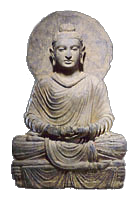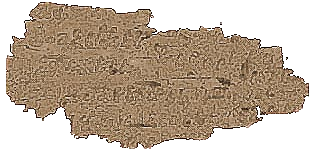

Oldest Buddhist Bark Texts

Visit the website: Early Buddhist Manuscript Project
The British Library / University of Washington Early Buddhist Manuscripts Project was founded in September 1996 in order to promote the study, editing, and publication of a unique collection of fifty-seven fragments of Buddhist manuscripts on birch bark scrolls, written in the Kharosthi script and the Gandhari (Prakrit) language that were acquired by the British Library in 1994. The manuscripts date from, most likely, the first century A.D., and as such are the oldest surviving Buddhist texts, which promise to provide unprecedented insights into the early history of Buddhism in north India and in central and east Asia.
Extract from an article by Dalya Alberge
The British Library has discovered remarkable manuscript fragments which it says may be as significant for Buddhist scholars as the Dead Sea Scrolls are for Christianity and Judaism. The manuscripts, birchbark scrolls that look like “badly rolled up cigars” when first shown to the library, are believed to be the earliest surviving Buddhist text. The exact origin is unknown beyond that they were probably found in Afghanistan in earthen jars.
“These will allow scholars to get nearer to what Buddha said than ever before,”the deputy director of the library’s Oriental and Indian Office Collection, Mr Graham Shaw said. They date from the end of the first century AD or the beginning of the second century AD. Apart from bringing scholars closer to the original language of the Buddha, this could corroborate the authenticity of teachings recounted in later text.
The manuscripts include 60 fragments, ranging from the Buddha’s sermons to poems and treatises on the psychology of perception. The library acquired them 18 months ago from a British dealer. “Their value was incalculable”, Mr Shaw said. ” How would you put a value on the Dead Sea Scrolls?” It is believed they are part of the long-lost canon of the Sarvastivadin Sect that dominated Gandhara – modern north Pakistan and east Afghanistan – and was instrumental in Buddhism’s spread into central and east Asia.
Gandhara was one of the greatest ancient centres of Buddhism. Mr Shaw explained: “The scrolls tell us something about the way Buddhists passed on the teachings, which were for a long time passed on orally.” After the Buddha’s death, his disciples are said to have gathered in assemblies where they recited his sermons and organised them into what came to be the Buddhist canon.
Although nothing is known of their provenance, their attribution has been confirmed by the University of Seattle’s Professor Richard Salomon, one of the world’s greatest scholars of Kharosthi – a script derived from the Aramaic alphabet that was restricted to a small area of India. They were, he said, “the Dead Sea Scrolls of Buddhism”. Years of study lay ahead before the text can be deciphered, analysed and compared with existing texts.
The fragments include tales told on Lake Anavatapata’s banks at an assembly of the Buddha and his disciples. Another is one of the Buddha’s sermons on the rhinoceros horn (Suttanipata). “The rhinoceros and its horn in particular is a symbol of non-attachment to material things … it is not a herd animal. It just wanders alone.”

